How Karnataka’s Aggressive Port Push Is Jeopardising Lands, Livelihoods Of Fishers
Karnataka’s aggressive port expansion displaces fisher communities, destroys livelihoods, and endangers coastal ecosystems, sparking powerful resistance led by women
- Aisiri Amin
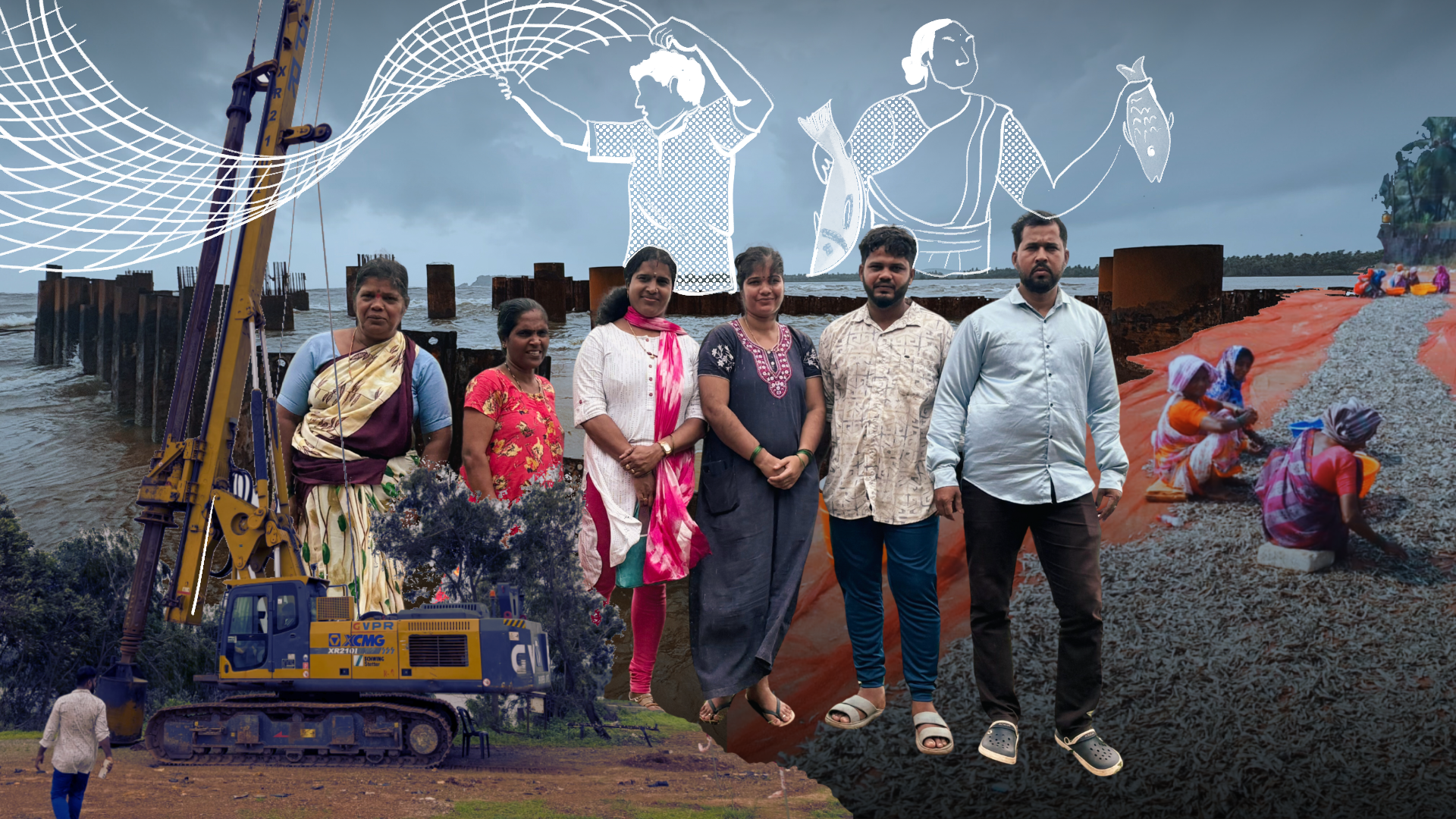
Rekha Tandel, 40, has a warmth about her that makes one smile instinctively. But now a kind of silence follows the woman fisher from Kasarkod village in Honnavar taluk. “She used to talk a lot and was very chirpy,” says her friend, Renuka Tandel.
Laughter vanished from Rekha’s life early this year. On February 25, she, along with a few women from her village, had jumped into the sea to protest the construction of a private port in the area. She sustained injuries and had to spend days in the hospital.
The Kasarkod port, when completed, could jeopardise the livelihoods of thousands of women fishers. After 14 years of a campaign that the authorities ignored, it seemed that only a drastic step would get the attention the crisis deserved.
But the incident has left Rekha traumatised and depressed with brief spells of memory loss. Before February, she ran a dry fish and prawn pickle making business. “I don’t remember how to make those pickles now,” she says with an empty expression.
This is not the first protest. The community of fishers had been protesting against the project for the last about 10 years. Along with the protests came the brutality of the police and dismissal by the State. Since 2016, Kasarkod village has seen a frequent presence of police, which became more pronounced after the Covid-19 pandemic.
On February 25, hundreds of fishers were detained, many were beaten, and FIRs were lodged against 45 fishers of Kasarkod village, including those who were not present in the area– including Rekha, who was in the hospital, and Bhaskar Tandel, who accompanied her–under as many as 13 sections of Bharatiya Nagarik Suraksha Sanhita (BNSS).
The under-construction Kasarkod port is at the mouth of the Sharavathi River in the village of Kasarkod Tonka in Uttara Kannada district. The Rs 607-crore port is being built by Honnavar Private Port Limited (HPPL), a consortium formed by North Canara Seaports Private Limited (NCS) and GVPR Engineers Limited (GVPREL). The plans included a barge/vessel loading facility in 44 hectares to handle 4.9 million tonnes of cargo per year.
“HPPL has the lease for 30 years. We will hand it over to the government after that,” says Tarakesh Phayde, port engineer, HPPL.
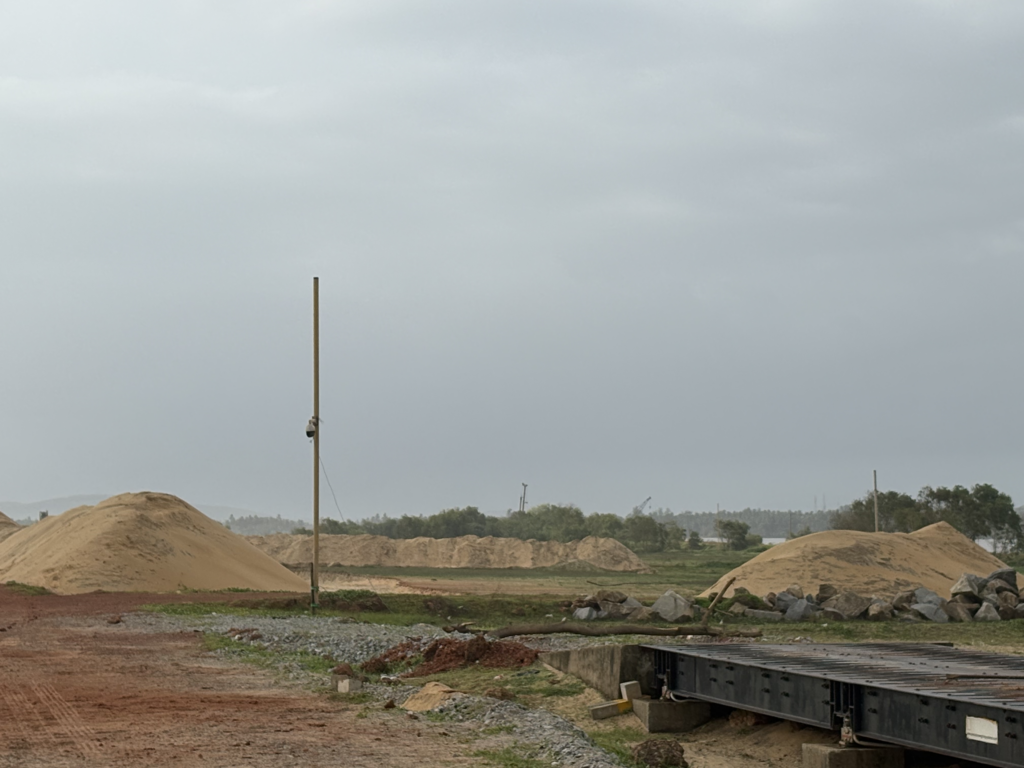
The fishing community of Kasarkod has been questioning the lack of transparency around the port project and the environmental clearances given to it, as we detail later. They fear that it’s not just their homes and work that will be hit, but also the sensitive ecology of the area which will be exposed to high levels of pollution. But despite the sustained campaign, state officials maintain that port projects such as this one boost employment and government earnings while improving infrastructure.
A four-lane road, measuring 2.58 km from the 44 hectare port land to National Highway 66, traversing through the Kasarkod Tonka village, is also being constructed. Once it meets the NH66, another 2 km is planned for the existing highway’s improvement. The plan also includes a service road and a railway connectivity line, measuring 8.5km, from the port site to the Konkan railway line, with a new railway station at Hosapattana.
The land available for fishers to conduct their businesses has been steadily decreasing over the years, says Mahabaleshwar Hegde, a researcher based in Uttara Kannada district and whose work has focused on coastal Karnataka. “Based on my unpublished research conducted in 2022, out of 132 revenue fishing villages, now only about 106 villages are left. Around 22 villages were acquired by the naval base, and two or three villages disappeared due to erosion. This is putting a lot of pressure on the coastal land and the fishers’ livelihood,” he says.
A 2021 paper co-authored by Hegde states that “construction and dredging activities damage shorelines and marine habitat and biodiversity, and impact the livelihoods of fishers and coastal communities”. The paper also points to the pollution caused by the handling of goods, oil spills during shipping, accidents and increased turbidity due to ship movement.
Despite being at the forefront of this resistance against the port for years, fishers have been excluded from the discussions on the project by the State, court, port authorities, or even people’s representatives, says Vidya Dinker, a social activist and director of Growthwatch, a voluntary research and advocacy institution. “They have been erased even though they are the most affected,” she says.
“Fishing is our only livelihood, and we don’t know anything else. If you take that away, we will starve,” says Parvati Datta Tandel, 49, a woman fisher in Kasarkod.
In a two part series, we document the aggressive push for ports by the Karnataka government and its economic, ecological, and social costs and the resistance of the fishers of the region to protect their lands and livelihoods. In part one,we look at the state’s port policy and its impact on the local economy and ecology. In the second part, we document the resistance movement against these ports and the physical, social, financial and mental costs of sustaining the resistance, on women fishers who have been at the forefront.
The Push For Ports
Karnataka has been making an aggressive push for more ports along its 320km coastline. It is already home to one major port, the New Mangalore Port, and 13 minor ports stretching across three coastal districts. Currently, there are 20 proposed projects in Karnataka relating to maritime projects, which include the construction of ports, road connectivity, extension of breakwater, and dredging.
Ten years ago, under the Sagarmala programme, a flagship central project to promote port-led development in India, 839 projects were approved at an estimated Rs. 5.79 lakh crores. By March 2025, 272 of these projects were completed. Now, the government is launching Sagarmala 2.0, with a budget of Rs 40,000 crore, to drive “infrastructure development, coastal economic growth, and job creation” in the next decade.
HC Balachandra, chief executive officer, Karnataka Maritime Board, says these port projects are important for development. “They help increase employment, revenue, income to the government, as well as infrastructure and logistic development in the local areas,” he says. He points out that currently all the cargo in Karnataka is being sent to the eastern coast. “By road and rail, the distance ranges from 250 to 900 km. Due to this, we are losing revenue, including shipping services such as port dues and levies. Employment is generated from import and export activities, which benefits other states right now,” he says.
But indigenous fishing communities say their voices have been ignored in this development work.
Keni, in Ankola taluk, has also become a battleground between the fishers and Jindal South West, a private company building a Rs 4,000 crore port in the area. In 2020, the coastal town of Karwar, fishers protested the Rs 2,000-crore expansion of the existing port, which the Supreme Court halted in 2022.
‘Land Not Suitable For Port’
The allotted land is not even suitable for port construction, argues marine biologist Prakash Mesta. “This is the fourth attempt to build a port in this area,” he says. According to him, the British colonial government attempted to construct one but failed. In 1960, an Indian government attempt too failed. Twelve years later, in 1972, the Port Department of Karnataka conceived of a jetty, which was eventually washed away.
“If you observe the area over the years, it’s clear that it is prone to erosion and accretion,” says Mesta. Accretion is a natural process which occurs when sand or gravel is deposited along the coastline, causing the re-emergence of land or the expansion of the land towards the sea.
These changes in its topography have also cast doubt on the ownership of this land. The concerns of fishers go back to 1979, when sea erosion at Mallukurva village in Honnavar taluk displaced 301 fisher families. Affected families were relocated to Kasarkod by the government as refugees of the Sharavathi river floods.
“The government in 1979, de-notified 24 acres and 20 guntas of port land, which was transferred to revenue land for rehabilitation,” says Sreeja Chakraborty, environmental lawyer. About 61 were rehabilitated, and the rest set up homes in the port land.
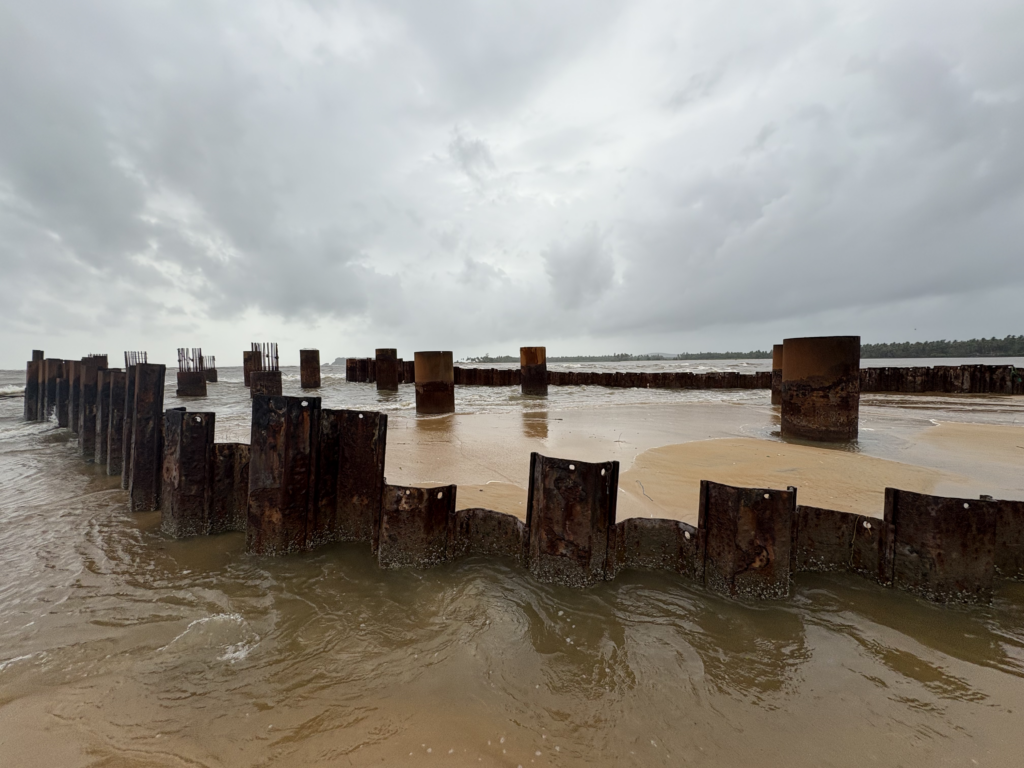
A few years later, in 1993, under the government’s Ashraya Yojana, 297 families received plots in Kasarkod, marked under survey number 303. Land survey numbers are unique numbers allotted to a particular piece of land by the state’s revenue department.
Over time, the submerged land re-emerged due to accretion and shifting of the fast moving river mouth. Maps from the 1950s and 60s show that the river mouth was 3.5 kms south of the current one. Fishers started using it for drying fish, a primary source of income for many households, especially women. Some also put up sheds in the area. “For many, the reemerged land is their ancestral property in Mallukurva, so they used it for their business until 2016,” Chakraborty says.
In late 2016, HPPL obtained an order from the Dharward bench of the Karnataka High Court to evict fishers from the area and take possession. “They were illegally occupying the land. It is government land which was leased to us in 2010,” insists Phayde. No alternative land was provided to the fishers to carry out their business.
Impact On Income
The dried fish business provides direct employment to around 2,000 women in Kasarkod. It also provides allied employment opportunities, such as loading and unloading and transportation of dried fish to drying yards. On average, the women earn about Rs 5,000 a month from selling dried fish.
Around 12,000 to 15,000 people were employed directly and indirectly all year-round, except during the monsoon season. Around 50,000 to 60,000 migrants also earn a living through activities related to fishing and the fish trade in Kasarkod village.
Girija Tandel, 62, was in her 30s when her husband passed away. She did not even have the privilege of grieving her loss. “The dried fish business made it possible for me to feed my four children,” she says.
Her neighbour, Gangi Datta Tandel, 80, who also lost her husband at a young age, has a similar story. “If you ask around, you will find many widowed fisherwomen who depend only on selling fish to keep their family afloat,” Girija says.
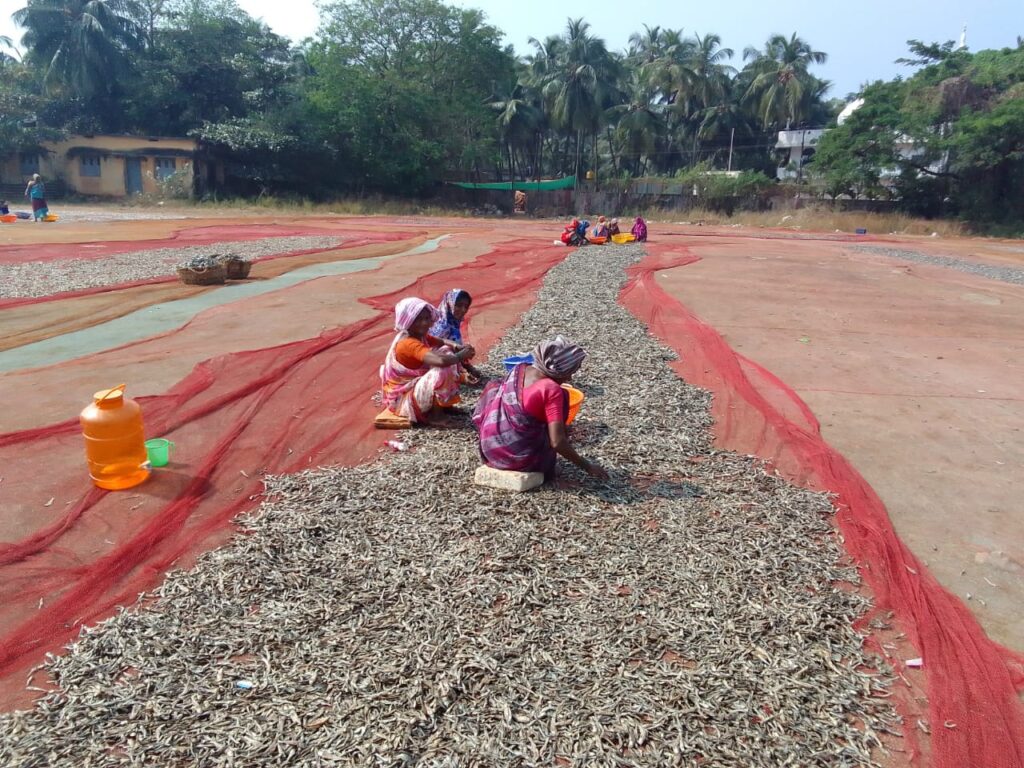
After losing access to the port land in 2016, another setback came in 2022 with the mud road along Tonka beach being replaced with a gravel road. For years, women fishers had used the area for drying fish. “If we don’t have space to dry fish or sell them, then how will we make money?” asks Parvati.
In recent years, the women say they have seen the constant movement of vehicles on the new road. “People prefer dried fish varieties with white colour. So, when dust from vehicles settles on this fish, it loses value. If we used to get Rs 250 for one kg, dust would reduce it to Rs 50,” Renuka says. The new road sits right in front of the fishers’ homes.
As she speaks, two cars pass by the gravel road, and within the next minute, two more pass by. “See,” she says.
‘Vague’ Environmental Clearance
The first environmental clearance (EC) was granted to the company after a public hearing in 2012, which was attended by just 10 participants, including four to five fishers from Kasarkod, all of who opposed the project.
“People weren’t made aware of the port project or its impact,” says Raju Datta Tandel, a resident.
In 2019, before the EC’s expiration, the company got it extended to 2022. They also received an extension of one year excusing the period lost due to COVID-19 and another additional year in 2023. Last year, three months before expiration, HPPL applied for a fresh EC and asked NGT to consider the 2012 public hearing—conducted 12 years ago—for the same.
The Karnataka State Environment Impact Assessment Authority (SEIAA) granted a new EC in December 2024 without a new public hearing on a Rapid Environment Impact Assessment. They also used a 2017 case of the Mumbai Port Trust for the EC, which Chakraborty says, is factually not similar.
Chakraborty calls this a violation and points out that according to the EIA Notification, 2006, and its 2021 Amendment, a public hearing is mandatory for new port projects outside notified industrial zones. The 2021 Amendment did state that if more than 50% of physical work is completed and the EC expires, “public hearing may be exempted” but according to Phayde, only 5% work has been finished.
Fishers have constantly challenged the new EC. In June 2025, the Southern Bench of the National Green Tribunal (NGT) dismissed two appeals challenging the EC granted to HPPL, and earlier this month, the Supreme Court dismissed the fishers’ appeal. The fishers are currently exploring further legal options.
There is also silence about the rehabilitation and resettlement of the affected fishers. In the documents submitted for EC last year, HPPL has not mentioned any plans. Phayde, however, reveals that discussions about compensation are currently ongoing. “We will come up with more details later this year. Some people might want land, cash, or both.We are identifying patches of land near the sea which can be given to the affected people. It is through the port department and district administration,” he says.
Olive Ridley Turtles At Risk
For the residents of Kasarkod village, the Olive Ridley turtles, who come to the beach area for nesting, hold a special place. “They usually come from February to April, and the eggs hatch in May. Last year, about 100 turtles came to lay eggs, but this year, because of the disturbance caused by the port project, the number is reduced to around 40,” says Ramesh Tandel.
The fishing community has a deep connection with these turtles, and they often remove the buildup on the shells and place nets around the eggs. “The turtles also help us because they eat the jellyfish and other sea creatures that keep the fish away,” says Raju.
The development work will affect the nesting area of the turtles, say the fishers. “They place big rocks near the area and flash bright lights in the night to disturb the turtles. They have even killed some turtles,” Ramesh alleges.
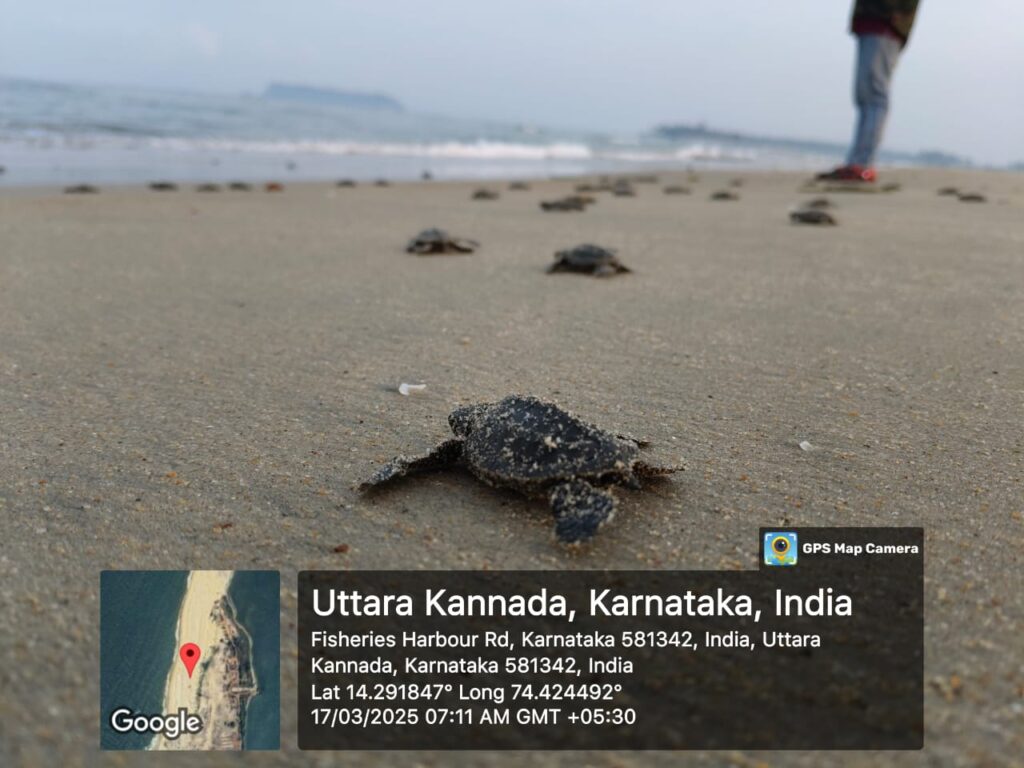
Phayde denies these allegations. He claims to have evidence that fishers are planting turtle eggs in the area. Raghavendra Reddy, executive director of HPPL maintains that the forest department has not classified the area as a turtle nesting region.
In August 2021, the National Centre for Sustainable Coastal Management (NCSCM) conducted a survey of the Olive Ridley turtles. As this was well outside the turtle nesting season, it’s not surprising that they didn’t identify any nests or turtles during this time.
Ramesh showed a number of videos of turtles laying eggs in the area. Chakraborty too says that HPPL’s own legal documents show the presence of Olive Ridley turtles. “In the 2021 High Court judgment, they said there are no turtles. In the 2023 NGT judgement, it became ‘occasional’, and now in the latest judgement, it is ‘sporadic.’ So, by their own admission, the turtles’ presence is increasing, so it’s even more important to conserve them,” she says.
Another Village On The Boil
In February, Kasarkod Tonka 1 and 2 were not the only villages protesting. About 60km north of the Kaskarkod coast, fishers in Ankola taluk’s Keni village had gathered at the beach in large numbers to voice their resistance to the development of a commercial port.
In November 2023, the Jindal South West Infrastructure (JSW) signed an agreement with the Karnataka government to construct a Rs 4,119 crore all-weather greenfield port in Keni. According to Land Watch Conflict, the agreement is between its subsidiary company, Masad Infra Services Pvt Ltd and Karnataka Maritime Board to develop a deep-water commercial port primarily for coal and steel cargo.
Fishers are complaining about the lack of transparency in this project too. “We found out about it only last year even though it drastically impacts our livelihood,” says Girija Soma Harikanta, 55, a resident.
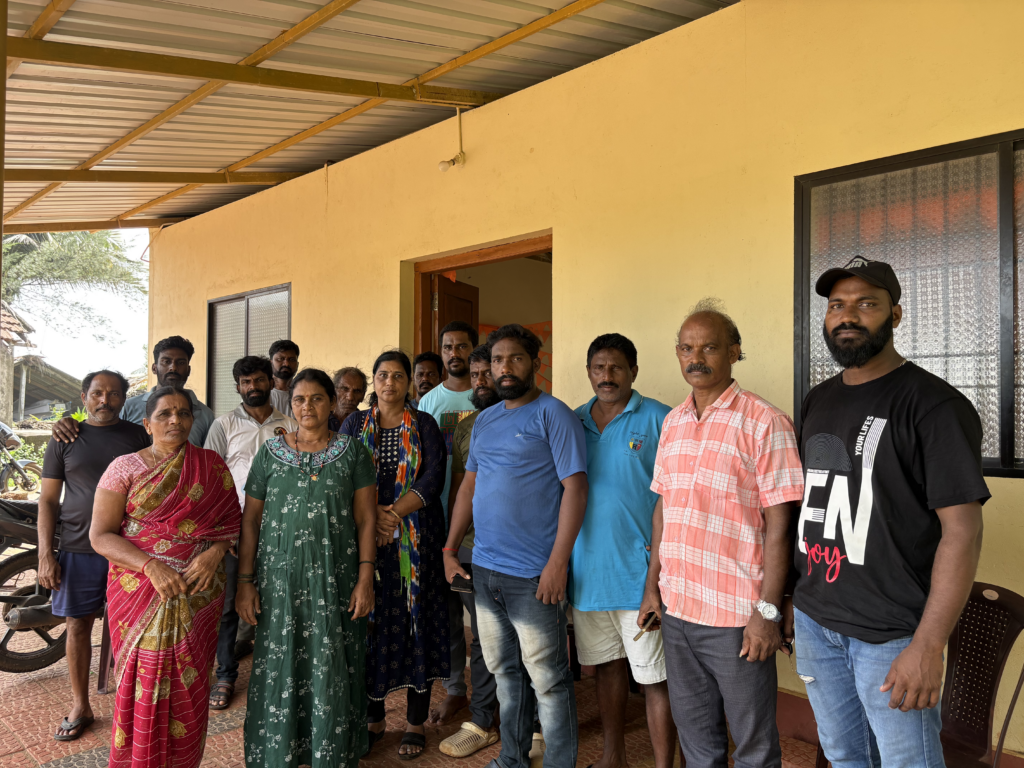
Last November, Keni’s fishers submitted a petition to the Tehsildar’s office in Ankola demanding the discontinuation of work on the proposed port. But it found no response. A few months later, on February 23 2024, around 8 pm, Section 144 was imposed in Keni prior to the geo-technical survey. “There wasn’t any incidence of violence in our village before this. So, why the need for section 144?” questions Sanjeev Balegar, a fisher from the village.
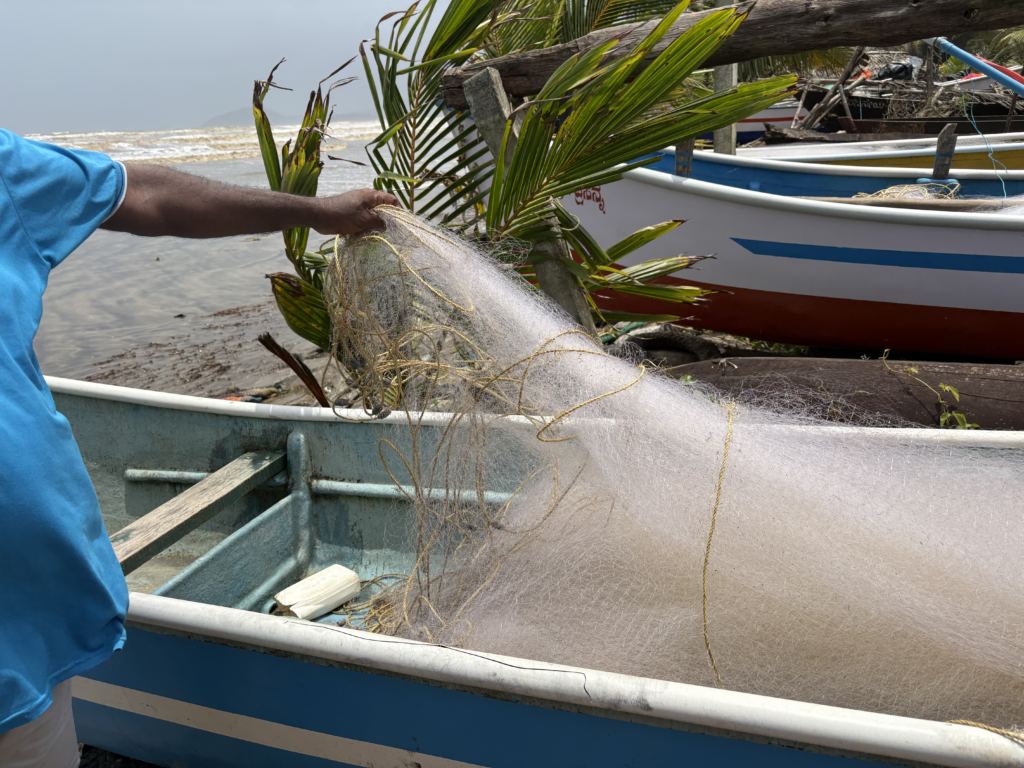
The next day, hundreds of fishers from the village started questioning the survey and gathered at the beach. Many of them, mostly women, jumped into the sea in protest. One of their main demands was meeting with the district collector Lakshmipriya K, who did not reach Keni until 5 pm, after the women had to be taken to the hospital.
“Do we have to risk our lives just to be heard?” Girija, one of the women who jumped, asks.
In Keni too fishing is a lifeline for the people, bringing in at least Rs 500 a day to families. Over the 14 days when Section 144 had been imposed and there was police presence in the area, fishing had come to a standstill, hitting many families. There were also complaints that a barge installed for the project had destroyed about 5kg of fishing net. “Each kg costs us at least Rs 1,000,” says Neelesh M Harikanta, a local fisher.
Unsustainable Port Spree
Researcher Mahabaleshwar Hegde says that Sagarmala undermines practical problems on the ground. “The environmental regulation agencies, such as SEIAA (State Environmental Impact Assessment Authority) and KSCZMA (Karnataka State Coastal Zone Management Authority the KSPCB (State Pollution Control Boards), are not efficient enough to assess and monitor so many development projects because lack of manpower, resources, training and expertise in these institutions,” he explains.
He adds that several conditions stipulated in the Environment Clearance (EC) letters are vague and lack a scientific basis. “For instance, if the clearance includes a condition to ensure adequate measures to avoid all contamination, who decides what is adequate?” Hedge asks.
In February 2024, Karnataka chief minister Siddaramaiah said the government expects an investment of Rs 20,000 crore in the coming years to tap into the potential of coastal Karnataka. This will be achieved by providing port, railway, and air connectivity in the region.
This increased focus on Karnataka’s coastline has also resulted in a slew of non-major ports, which are just 40km apart from each other, with some being in the same taluk. For instance, Keni and Belekiri ports come under Ankola taluk, while Pavinakurke and Honnavar ports are in Honnavar taluk.
According to the Karnataka Minor Ports Development Policy of 2014, ports, which are “trade gateways of the state”, are important for “addressing the rising import and export traffic.”
However, data from 2022 showed that apart from the port at Karwar, no other minor port has shown an increase in its exports and imports in the last five years.
While Tadadi, Honnavar, Manki, Pavinkurve, Bhatkal and Padubidri are not commercial ports yet, ports at Belekeri, Kundapura and Hangarkatta show no cargo handling data after 2018, as per the data. In fact, ports at Malpe and Old Mangalore have shown a reduction in business.
Furthermore, cargo managed by non-major ports in Karnataka declined in the last financial year. In 2023-24, Karnataka handled 0.89 million tonnes of cargo, which is less than the 1.06 million tonnes handled during 2022-23.
“Currently, the operational ports are Karwar and Mangalore. The others are yet to be developed. Due to a lack of facilities, we are unable to operate them yet,” Balachandra says. For the development of non-major ports, the government is looking at private sector participation, as per the aforementioned 2014 policy.
“There are no bidders for these ports. They have only two takers right now, HPPL and JSW. They need 10 more takers. If this is an amazing development plan, why are there no takers?” Chakraborty asks. “One of the key reasons for the lack of investors is that these are highly populated fishing villages and estuaries in port areas.”
Vidya Dinker, a social activist and director of Growthwatch, a voluntary research and advocacy institution, calls this “extractive land use” because while the state and private sector focus on big infrastructure development projects, fishing communities are left homeless and jobless. “How is it ‘development’ when there are basic human rights violations, forced displacement of thousands of fishers, and the demolition of their homes?” she asks.
Hegde says the aggressive push for the port-led activity will run into public opposition. “Coastal communities will not be able to cooperate with these many projects. In Karnataka, especially in Uttara Kannada, people have given up a lot of land to the naval-base projects (INS Kadamba), large hydropower projects, and the national highway,” he says.
We believe everyone deserves equal access to accurate news. Support from our readers enables us to keep our journalism open and free for everyone, all over the world.

